Crafting Pickaxes, swords and social skills
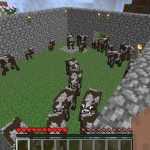 Since its release in 2009, Minecraft has made its way into 60 million homes worldwide and has become the best-selling PC game of all time. The game can now be played on multiple platforms, including XBox, Playstation, and most smart phones and tablets. There are Youtube videos with literally millions of views of people playing Minecraft while providing their own commentary. Shoppers can now purchase Lego sets, T-shirts, keychains, books, foam pickaxes, costumes, and so much more. For educators, it’s becoming nearly impossible to make it through a day without hearing children talk about Minecraft.
Since its release in 2009, Minecraft has made its way into 60 million homes worldwide and has become the best-selling PC game of all time. The game can now be played on multiple platforms, including XBox, Playstation, and most smart phones and tablets. There are Youtube videos with literally millions of views of people playing Minecraft while providing their own commentary. Shoppers can now purchase Lego sets, T-shirts, keychains, books, foam pickaxes, costumes, and so much more. For educators, it’s becoming nearly impossible to make it through a day without hearing children talk about Minecraft.
So how can teachers use Minecraft in the classroom?
Many educators have already been using the game to teach geometry, history, reading and writing. If you’re curious as to some of the ideas being used out there, just do a quick search online with the subject content you’re teaching and chances are, you will discover some useful information (even some well thought-out units). Here at the Centerpoint School, we noticed the student interest and created a Minecraft Club that focuses on social skill development.
The idea of teaching social skills through the use of video games seems to contradict itself, but in today’s world, more and more video games are offering online multiplayer content. Players now need to work together as a team, communicate clearly with one another, and hold each other accountable for their actions. In other words, students playing Minecraft in the same world has become pretty similar to kids playing on the same sports team in terms of social skill development.
Centerpoint’s Minecraft Club really began in April of 2014, when Special Education Coordinator Dana Visser recognized the need to get Minecraft in our school.
We had a lot of students who were reluctant to participate with others in any activity, and were convinced they had nothing in common with their peers. A handful of students rarely engaged in conversation with others, and would pass each other in the hallway with a lack of trust in their eyes. There was little to no motivation to interact with one another, and students were completely satisfied in keeping things that way.
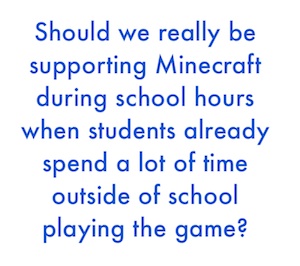 Dana brought the idea of a Minecraft Club to the school’s leadership team, and some thoughtful questions led to an important discussion of considerations. What are the benefits of such a club? What are the risks? Should we really be supporting Minecraft during school hours when students already spend a lot of time outside of school playing the game?
Dana brought the idea of a Minecraft Club to the school’s leadership team, and some thoughtful questions led to an important discussion of considerations. What are the benefits of such a club? What are the risks? Should we really be supporting Minecraft during school hours when students already spend a lot of time outside of school playing the game?
The biggest challenge to overcome was the notion that video games do not belong at school, and that there are other methods of developing social skills which do not involve sitting in front of a computer screen. But by holding onto a traditional educational viewpoint, would we be missing out on a new and exciting opportunity? After the conversation, Centerpoint leadership felt a lot of positive benefits could result from a Minecraft Club, and the green light was given.
The Centerpoint School purchased several Minecraft licenses through MinecraftEdu, a version of the game that not only includes regular Minecraft, but also a classroom-friendly edition designed specifically for educators. The company also offers a discount on the game to qualified educational institutions, and has recently started offering the ability to host school servers.
Once the licenses were purchased and Minecraft was installed on a handful of school computers, the club was ready to begin. At first, the goal was to have 3-4 students play the game in a parallel way: in the same room, playing the same game, but each in their own world.
Participating in the same activity in the same room with others was a pretty big step for some of our students, and we wanted to eliminate the possibility of student conflict in a shared world. These students did not trust each other entirely, and for the initial start we wanted them to feel safe together. Playing Minecraft in a parallel way lasted for several months, through the summer of 2014. During this time, students shared their individual worlds with one another, taught each other tricks, asked and answered questions, and just enjoyed a shared interest together.
The next step was to get students in the same world, which required a server.
At the start of the 2014-15 school year, I contacted Philip England at Laboratory B in Burlington, a local non-profit focused on bringing together people with technical knowledge in order to share ideas, solve problems, and assist the surrounding community. The folks at Laboratory B had helped create the infrastructure for a civic cloud server, available for public use, and were happy to establish a Centerpoint Minecraft server on the civic cloud.

At this point, Minecraft Club was expanded to 5 students, and they were asked to come up with a list of expectations for the server. What rules did they think were important? How should the group resolve conflicts? Teachers facilitated the group discussion in an intentional way, allowing students to lead the discussion, while asking clarifying questions and helping steer conversations in the right direction.
The whole process was very similar to a group of kids coming together to play at recess: We’re all here, now what? How do we start a conversation? How do we decide what to do? How do we come up with rules? How do I pitch an idea to others? How do I collaborate and make compromises? Having this group discussion allowed these answers to come up quite organically.
Once the main expectations were established, students entered the shared world on the server. Within minutes, students were talking about shared goals and teaming up together. Inexperienced players began asking the Minecraft veterans questions, giving them practice on how to ask for help. Experienced gamers took pride in being knowledgeable and helping others, contributing to a positive sense of self. Almost immediately, students saw the need for a shared living space and began construction of a “community center.” Kids who once had difficulty passing each other in the hallway with a smile were now eager to build virtual bedrooms next to one another.
However, life on the shared server hasn’t always been butterflies and rainbows.
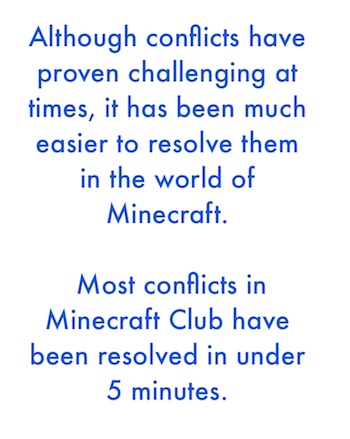 Within the first few sessions, peer conflicts made their appearance. Students who had difficulty asking questions and managing impulsive behaviors were taking valuable items from others’ chests. Although these conflicts have proven challenging at times, it has been much easier to resolve them in the world of Minecraft.
Within the first few sessions, peer conflicts made their appearance. Students who had difficulty asking questions and managing impulsive behaviors were taking valuable items from others’ chests. Although these conflicts have proven challenging at times, it has been much easier to resolve them in the world of Minecraft.
Instead of a student stealing an item and running off in the real world, the student was running away in the virtual world… while still sitting a few feet from their victim. Sometimes it would take some work to find out what exactly had happened, but the beauty of having both students in the same space made the reparative conversations so much easier.
As a result, most conflicts in Minecraft Club have been resolved in under 5 minutes. Students are learning how to advocate for themselves, resolve conflicts, and repair relationships in a peaceful manner… such valuable social skills in life.
That being said, there have been larger conflicts where the repair work has lasted weeks.
But even in the most challenging of moments, children have not been resorting to physical violence, choosing instead to seek revenge with virtual buckets of lava. Although chasing others around with buckets of lava isn’t exactly the social skill we’re looking to encourage, the relational repair work is much easier to get through versus a conflict that ends with real physical aggression. In addition, at the end of each conflict, students come together to brainstorm new amendments to be added to the list of Minecraft expectations.
Looking back on the past year, Centerpoint’s Minecraft Club has proven to be a huge success. Students have gone from “I have nothing in common with _______” to “_______ is cool, he likes Minecraft too.” Club members have expressed that they now trust each other more, and some of them are now identifying other group members as friends. Kids have created their own government, engaged in positive teamwork, practiced healthy communication, made compromises with others, and resolved conflicts.
I would highly encourage other educators to use Minecraft as a way of teaching social skills, while keeping the following thoughts in mind:
- Let the students create the rules – Establishing group expectations can be empowering for students. It is also helpful when a student violates a rule to say “this is what you all agreed on” as opposed to “these are the rules.”
- Be curious – I don’t know too many staff who are Minecraft experts, but I do know many students who are. Allow them to be the experts. Ask questions and demonstrate a genuine desire to learn about the game from them. If teachers are disconnected, there can be a lack of community feeling. In addition, it’s best to know the game so you can have a better understanding when conflicts arise.
- Be patient – Teaching social skills takes work. When conflicts arise, slow things down. Be curious, ask questions, and listen to all sides of the story. Try and let students resolve conflicts to the best of their abilities, but help steer them in the right direction.
- Play with them – Having staff on a server is very similar to having a teacher in the classroom. I have noticed students feel much safer when a teacher is in the world, and it becomes much easier to work on goals together.
If you have any questions, please be in touch. Otherwise, happy crafting!
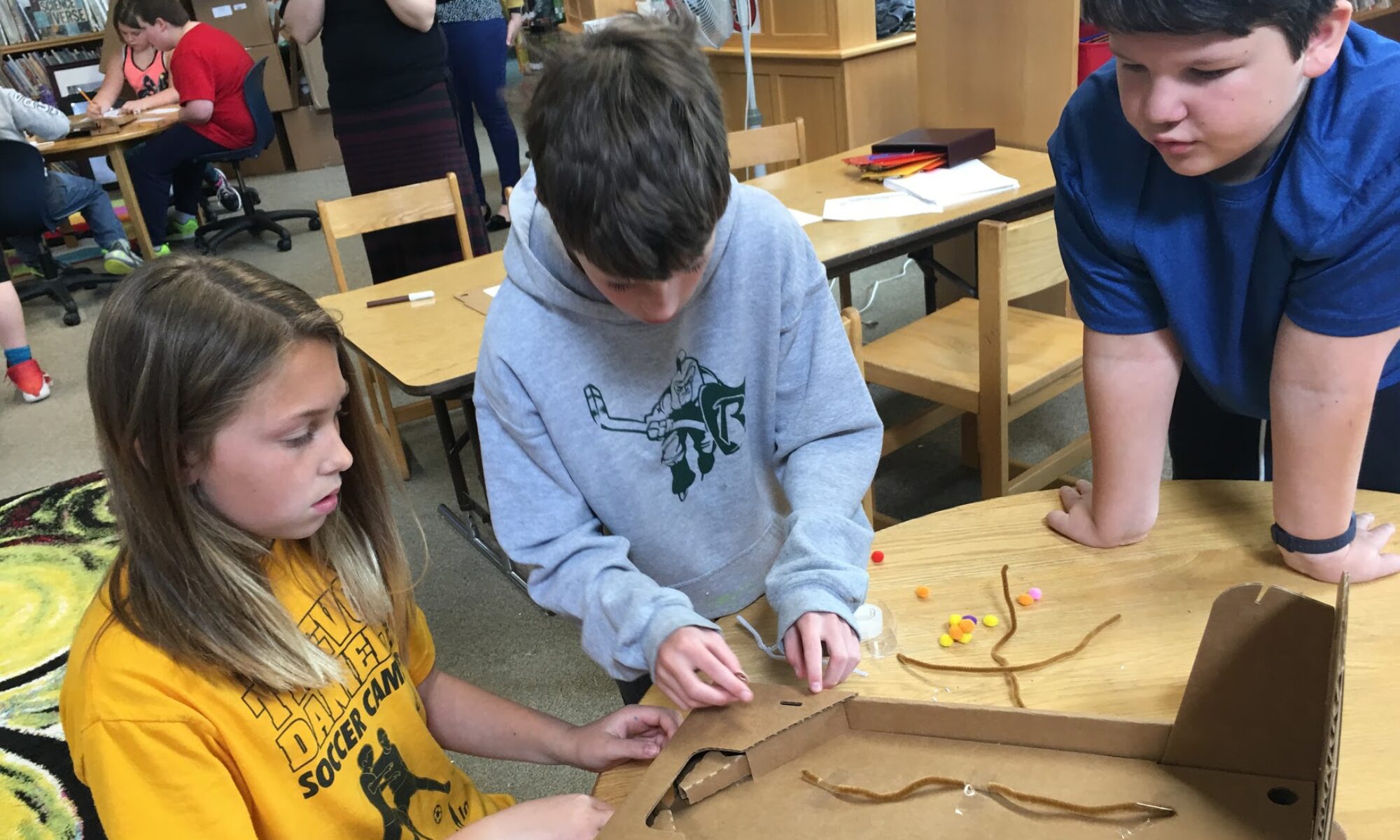

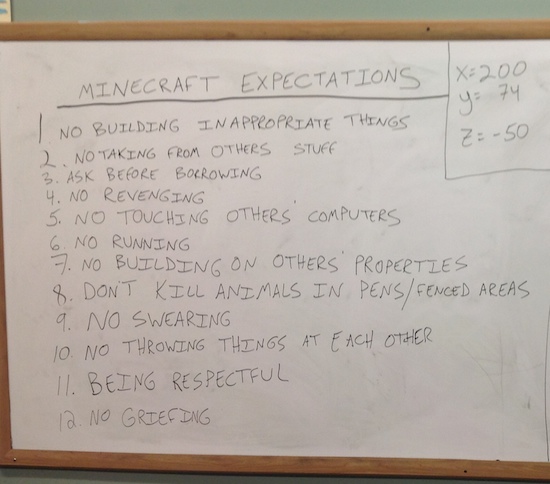
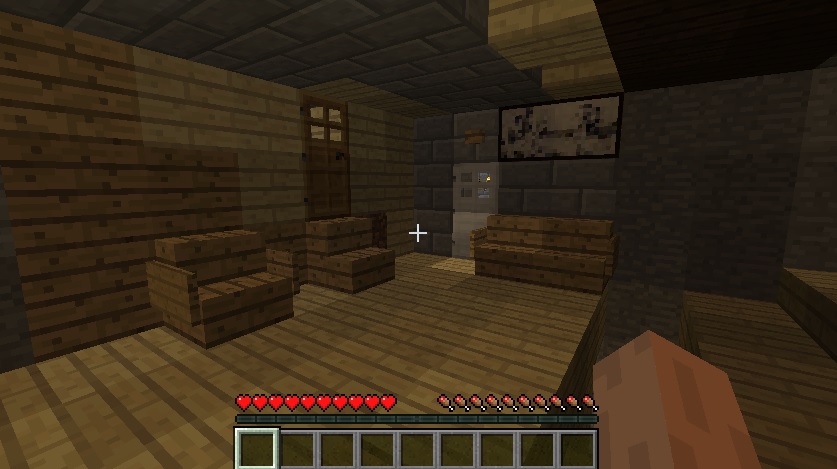
Check out this Minecraft Club: “Crafting pickaxes, swords and social skills” http://t.co/HThRmADsIX #vted
For the p.m. crowd, The Centerpoint School shares how they’re using Minecraft to build community http://t.co/jNFE1o5thp #vted
RT @innovativeEd: Check out this Minecraft Club: “Crafting pickaxes, swords and social skills” http://t.co/HThRmADsIX #vted
Great article. I am liking all the ways teachers and schools are using Minecraft or Edu to connect to kids and school lessons. Mike B. In Putney, Minecraft Edu teacher in Putney, VT